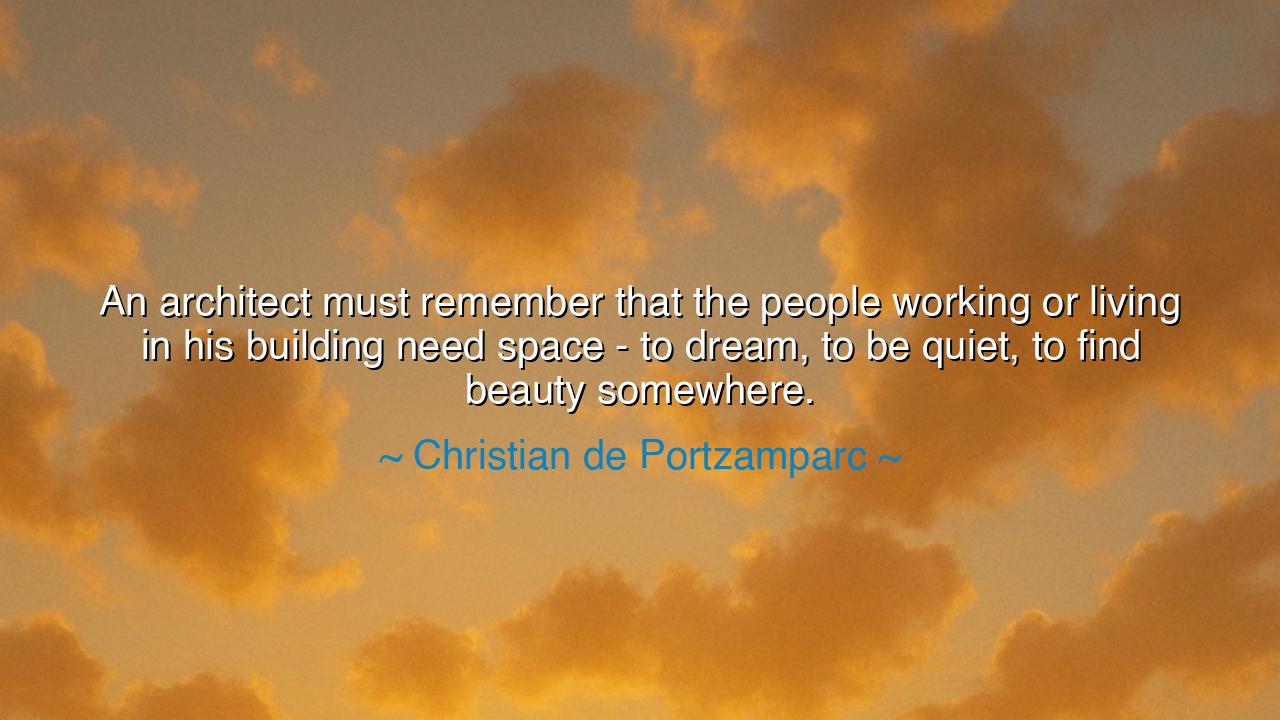
An architect must remember that the people working or living in
An architect must remember that the people working or living in his building need space - to dream, to be quiet, to find beauty somewhere.






Hear the voice of Christian de Portzamparc, master builder of spaces and shaper of human dwelling, who proclaimed: “An architect must remember that the people working or living in his building need space—to dream, to be quiet, to find beauty somewhere.” In this wisdom, he reveals that architecture is not merely the arranging of walls and ceilings, but the shaping of human souls. A house, an office, a hall is more than stone and steel—it is a vessel for dreams, a sanctuary for quiet, a stage for beauty.
The origin of this thought lies in Portzamparc’s philosophy of urbanism and design. As one who built not only towers but living neighborhoods, he knew that the truest measure of architecture is not its grandeur, but its ability to nurture life. Buildings are not for architects, but for people; and people, in their depths, require more than function. They require space—not only physical, but spiritual. A building that gives no breathing room to imagination or peace may stand tall, but it fails in its purpose.
The ancients knew this truth, though they spoke in different tongues. The Greeks raised temples not merely as structures, but as places where mortals might touch the divine. The Romans built baths and forums not only for utility, but as spaces where citizens might reflect, converse, and encounter beauty. And in the East, the gardens of Japan and China were woven into architecture, providing pockets of silence and grace. Each culture understood: a building must give its inhabitants more than shelter—it must give them a chance to live as whole beings.
Consider the story of Antoni Gaudí and his masterpiece, the Sagrada Família in Barcelona. He did not raise its spires merely for spectacle. He filled its columns with the likeness of trees, its windows with flowing light, its ceiling with the vastness of the sky. He gave to those who entered not only a place to worship, but space to dream, to be quiet, to find beauty in the ordinary play of color and form. Though incomplete in his lifetime, the building became a living sermon of this truth: architecture must nourish the inner life, not only the outer body.
The emotional force of Portzamparc’s words rests in their gentleness. Too often, the world exalts buildings as monuments to power, wealth, or ambition. Yet he calls the architect back to humility: to remember the people who will walk the corridors, who will sit in the light by a window, who will seek a corner for silence. To give such spaces is not trivial—it is to acknowledge the dignity of the human soul, its need for rest and for beauty. Without such care, walls become prisons; with it, walls become homes.
The lesson for us is clear: whether we are architects of stone or of life, we must give space to others. A parent must give a child room to dream. A leader must give followers room to be quiet. A friend must give another the chance to find beauty somewhere in the midst of struggle. We are all builders, not of cities perhaps, but of relationships, of homes, of communities. And in all these, the principle is the same: leave room for the soul to breathe.
So let your practice be this: in your life and work, do not crowd others with endless demands, nor fill every space with noise and busyness. Leave silence, leave beauty, leave freedom. Open a window for light to enter, carve out a corner for rest, and create spaces where dreams may rise. For as Christian de Portzamparc teaches, the noblest building is not the one that dazzles from afar, but the one that sustains life within, giving to its people the most precious gift: the space to be fully human.






AAdministratorAdministrator
Welcome, honored guests. Please leave a comment, we will respond soon